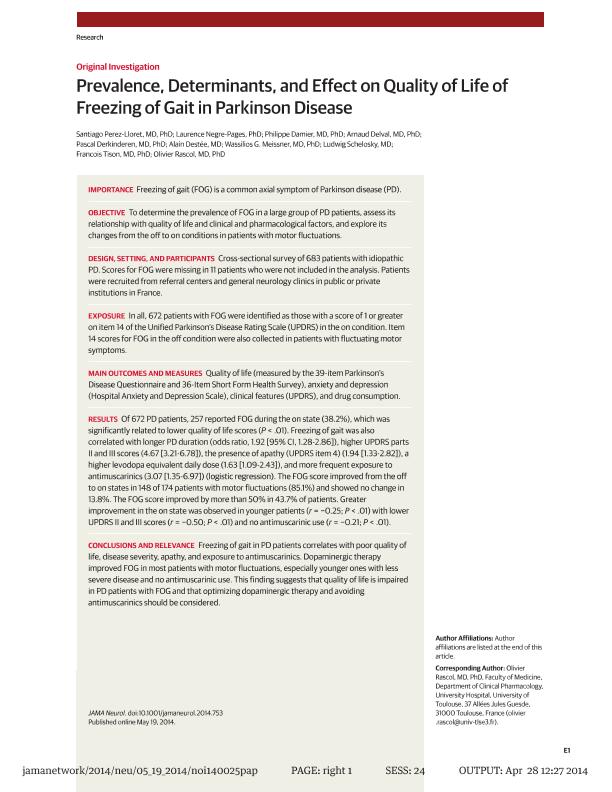Artículo
Prevalence, determinants, and effect on quality of life of freezing of gait in Parkinson disease
Perez Lloret, Santiago ; Negre Pages, Laurence; Damier, Philippe; Delval, Arnaud; Derkinderen, Paul; Destée, Alain; Meissner, Wassilios G.; Schelosky, Ludwig; Tison, Francois; Rascol, Olivier
; Negre Pages, Laurence; Damier, Philippe; Delval, Arnaud; Derkinderen, Paul; Destée, Alain; Meissner, Wassilios G.; Schelosky, Ludwig; Tison, Francois; Rascol, Olivier
 ; Negre Pages, Laurence; Damier, Philippe; Delval, Arnaud; Derkinderen, Paul; Destée, Alain; Meissner, Wassilios G.; Schelosky, Ludwig; Tison, Francois; Rascol, Olivier
; Negre Pages, Laurence; Damier, Philippe; Delval, Arnaud; Derkinderen, Paul; Destée, Alain; Meissner, Wassilios G.; Schelosky, Ludwig; Tison, Francois; Rascol, Olivier
Fecha de publicación:
07/2014
Editorial:
Amer Medical Assoc
Revista:
JAMA Neurology
ISSN:
2168-6149
e-ISSN:
2168-6157
Idioma:
Inglés
Tipo de recurso:
Artículo publicado
Clasificación temática:
Resumen
IMPORTANCE: Freezing of gait (FOG) is a common axial symptom of Parkinson disease (PD). OBJECTIVE: To determine the prevalence of FOG in a large group of PD patients, assess its relationship with quality of life and clinical and pharmacological factors, and explore its changes from the off to on conditions in patients with motor fluctuations. DESIGN, SETTING, AND PARTICIPANTS: Cross-sectional survey of 683 patients with idiopathic PD. Scores for FOG were missing in 11 patients who were not included in the analysis. Patients were recruited from referral centers and general neurology clinics in public or private institutions in France. EXPOSURE: Patients with FOG were identified as those with a score of 1 or greater on item 14 of the Unified Parkinson's Disease Rating Scale (UPDRS) in the on condition. Item 14 scores for FOG in the off condition were also collected in patients with fluctuating motor symptoms. MAIN OUTCOMES AND MEASURES: Quality of life (measured by the 39-item Parkinson's Disease Questionnaire and 36-Item Short Form Health Survey), anxiety and depression (Hospital Anxiety and Depression Scale), clinical features (UPDRS), and drug consumption. RESULTS: Of 672 PD patients, 257 reported FOG during the onstate (38.2%), which was significantly related to lower quality of life scores (P < .01). Freezing of gait was also correlated with longer PD duration (odds ratio, 1.92 [95% CI, 1.28-2.86]), higher UPDRS parts II and III scores (4.67 [3.21-6.78]), the presence of apathy (UPDRS item 4) (1.94 [1.33-2.82]), a higher levodopa equivalent daily dose (1.63 [1.09-2.43]), and more frequent exposure to antimuscarinics (3.07 [1.35-6.97]) (logistic regression). The FOG score improved from the off to on states in 148 of 174 patients with motor fluctuations (85.1%) and showed no change in 13.8%. The FOG score improved by more than 50% in 43.7% of patients. Greater improvement in the on state was observed in younger patients (r = -0.25; P < .01) with lower UPDRS II and III scores (r = -0.50; P < .01) and no antimuscarinic use (r = -0.21; P < .01). CONCLUSIONS AND RELEVANCE: Freezing of gait in PD patients correlates with poor quality of life, disease severity, apathy, and exposure to antimuscarinics. Dopaminergic therapy improved FOG in most patients with motor fluctuations, especially younger ones with less severe disease and no antimuscarinic use. This finding suggests that quality of life is impaired in PD patients with FOG and that optimizing dopaminergic therapy and avoiding antimuscarinics should be considered.
Palabras clave:
Parkinson Disease
,
Movement Disorders
,
Quality of Life
,
Medical Treatment
Archivos asociados
Licencia
Identificadores
Colecciones
Articulos(OCA HOUSSAY)
Articulos de OFICINA DE COORDINACION ADMINISTRATIVA HOUSSAY
Articulos de OFICINA DE COORDINACION ADMINISTRATIVA HOUSSAY
Citación
Perez Lloret, Santiago; Negre Pages, Laurence; Damier, Philippe; Delval, Arnaud; Derkinderen, Paul; et al.; Prevalence, determinants, and effect on quality of life of freezing of gait in Parkinson disease; Amer Medical Assoc; JAMA Neurology; 71; 7; 7-2014; 884-890
Compartir
Altmétricas



